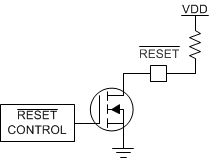ZHCSO90A november 2022 – april 2023 TPS36-Q1
PRODUCTION DATA
- 1
- 1 特性
- 2 应用
- 3 说明
- 4 Revision History
- 5 器件比较
- 6 Pin Configuration and Functions
- 7 Specifications
- 8 Detailed Description
- 9 Application and Implementation
- 10Device and Documentation Support
- 11Mechanical, Packaging, and Orderable Information
9.2.1.2.5 Calculating the RESET Pullup Resistor
The TPS36-Q1 uses an open-drain configuration for the RESET output, as shown in Figure 9-2.When the FET is off, the resistor pulls the drain of the transistor to VDD and when the FET is turned on, the FET pulls the output to ground, thus creating an effective resistor divider. The resistors in this divider must be chosen to ensure that VOL is below its maximum value. To choose the proper pullup resistor, there are three key specifications to keep in mind: the pullup voltage (VPU), the recommended maximum RESET pin current (IRST), and VOL. The maximum VOL is 0.3 V, meaning that the effective resistor divider created must be able to bring the voltage on the reset pin below 0.3 V with IRST kept below 2 mA for VDD ≥ 3 V and 500 μA for VDD = 1.5 V. For this example, with a VPU =VDD = 1.5 V, a resistor must be chosen to keep IRST below 500 μA because this value is the maximum consumption current allowed. To ensure this specification is met, a pullup resistor value of 10 kΩ was selected, which sinks a maximum of 180 μA when RESET is asserted.
 Figure 9-2 Open-Drain RESET Configuration
Figure 9-2 Open-Drain RESET Configuration